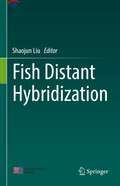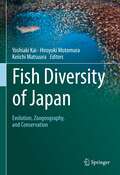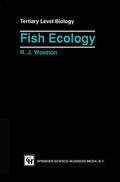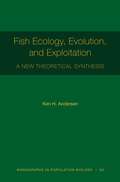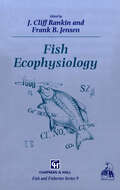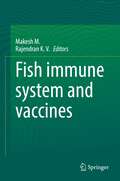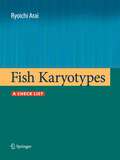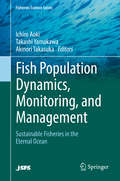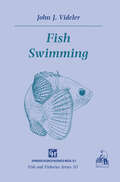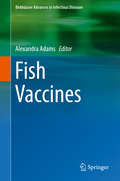- Table View
- List View
Fish Distant Hybridization
by Shaojun LiuThe book introduces fish distant hybridization, which covers the basic theory and applications of fish distant hybridization as well as the main biological characteristics of different ploidy fish at the individual, tissue, cell, and molecular level. It is divided into 12 Chapters. The research progresses of animal distant hybridization and polyploids in domestic and overseas are summarized in this book. The characteristics of these hybrids and polyploid fish are also illustrated on basis of considering factors of the chromosomes numbers, phylogenetic relationship, reproduction, appearance, feeding habits, growth rate, and stress resistance. The creation of fish distant hybridization lineages will provide a clear genetic background which is helpful for the study of the strain generation as a model in genetic variation characteristics and reproductive characteristics. Fully illustrated in color, this book provides unique ideas in system description and presentation of distant hybridization and polyploidy fish. In fish genetic breeding, the tetraploid fish lineage and diploid fish lineage, formed through distant hybridization, can be used for preparing large-scale triploid and diploid fish. This book is a useful reference for researchers in fish genetic breeding, aquaculture, developmental biology, and animal evolution, and serves as a valuable resource for students and researchers engaging in zoology, evolutionary biology, and genetics.
Fish Diversity of Japan: Evolution, Zoogeography, and Conservation
by Yoshiaki Kai Hiroyuki Motomura Keiichi MatsuuraThis book reviews and summarizes the studies on the fish diversity of Japan. It covers the present knowledge of ichthyofauna, habitat distribution, phylogeography, ecology, morphology, and conservation, as well as the history of ichthyology and fish collections in Japan. The book comprises five parts: I. Fish Diversity and Ichthyology of Japan, II. Habitat Distribution and Species Diversity, III. Diversity within Species: Phylogeographic Perspective on Japanese Fishes, IV. Morphological and Ecological Diversifications, and V. Conservation of Fish Diversity in Japan. The Japanese Archipelago is surrounded by two major warm and one cold currents. It is located in the western North Pacific and encompasses several climatic regimes from north to south. Although the land area of Japan is small, the Exclusive Economic Zone (EEZ) of Japan ranks as the sixth largest in the world, including several marginal seas (Sea of Okhotsk, Sea of Japan, and East China Sea), and deep trenches (Izu-Ogasawara, Japan, and Kurile Trenches). Owing to a variety of marine habitats and a complex geological history, Japan has a rich fish species diversity, representing over 4,500 species in 370 families. The richness of fish species diversity has attracted many scientists since the late 1700s, and continuous studies have led to the development of ichthyology in Japan. With chapters written by leading experts in the field, the book will provide a stimulating and reliable resource for future research and contribute to the progress of ichthyology of the world.
Fish Ecology (Tertiary Level Biology)
by R. J. WoottonFishes live in a world that is unfamiliar to us. Although we may make or even more advanced brief visits to this other world using a snorkel, scuba diving equipment, we can never become a part of it. Yet, an understanding of fish ecology requires an awareness of the relationships between fishes and their environment. The purpose of this book is to introduce the ecology of fishes by describing the inter-relationships between fishes and the aquatic habitats they occupy. The book can be read in complementary ways. A sequential reading, chapter by chapter, covers the main themes of ecology, including habitat use, species interactions, migration, feeding, population dynamics and reproduction in relation to the major habitats occupied by fishes. An alternative reading selects a particular sort of habitat, such as rivers, and, by using the index and skipping from chapter to chapter, builds up a picture of the ecology of fishes living in that habitat. The text is written for advanced students. Its emphasis is on descriptive rather than quantitative ecology. It is assumed that the reader will be familiar with the basic biology of fishes, acquired from a text such as The Biology of Fishes (Bone and Marshall, 1982) also published in the Tertiary Level Biology series. I would like to thank Dr J. D. Fish and two anonymous reviewers who, within a tight time-schedule, tried to improve the text. Any mistakes and shortcomings are my contribution.
Fish Ecology, Evolution, and Exploitation: A New Theoretical Synthesis (Monographs in Population Biology #93)
by Ken H. AndersenFish are one of the most important global food sources, supplying a significant share of the world’s protein consumption. From stocks of wild Alaskan salmon and North Sea cod to entire fish communities with myriad species, fisheries require careful management to ensure that stocks remain productive, and mathematical models are essential tools for doing so. Fish Ecology, Evolution, and Exploitation is an authoritative introduction to the modern size- and trait-based approach to fish populations and communities.Ken Andersen covers the theoretical foundations, mathematical formulations, and real-world applications of this powerful new modeling method, which is grounded in the latest ecological theory and population biology. He begins with fundamental assumptions on the level of individuals and goes on to cover population demography and fisheries impact assessments. He shows how size- and trait-based models shed new light on familiar fisheries concepts such as maximum sustainable yield and fisheries selectivity—insights that classic age-based theory can’t provide—and develops novel evolutionary impacts of fishing. Andersen extends the theory to entire fish communities and uses it to support the ecosystem approach to fisheries management, and forges critical links between trait-based methods and evolutionary ecology.Accessible to ecologists with a basic quantitative background, this incisive book unifies the thinking in ecology and fisheries science and is an indispensable reference for anyone seeking to apply size- and trait-based models to fish demography, fisheries impact assessments, and fish evolutionary ecology.
Fish Ecophysiology (Fish & Fisheries Series #9)
by J.C. Rankin Frank B. JensenAmong the fishes. a remarkably wide range of biological adaptations to diverse habitats has evolved. As well as living in the conventional habitats of lakes. ponds, rivers, rock pools and the open sea, fish have solved the problems of life in deserts. in the deep sea. in the cold antarctic. and in warm waters of high alkalinity or of low oxygen. Along with these adaptations, we find the most impressive specialisations of morphology, physiology and behaviour. For example we can marvel at the high-speed swimming of the marlins. sailfish and warm-blooded tunas, air-breathing in catfish and lungfish. parental care in the mouth-brooding cichlids and viviparity in many sharks and toothcarps. Moreover, fish are of considerable importance to the survival of the human species in the form of nutritious. delicious and diverse food. Rational exploi management of our global stocks of fishes must rely upon a detailed tation and and precise insight of their biology. The Chapman [.,. Hall Fish and Fisheries series aims to present timely volumes reviewing important aspects of fish biology. Most volumes will be of interest to research workers in biology. zoology. ecology and physiology but an additional aim is for the books to be accessible to a wide spectrum of non-specialist readers ranging from undergraduates and postgraduates to those with an interest in industrial and commercial aspects of IIsh and t1sheries.
Fish Histology: Female Reproductive Systems
by Donald B. McMillanThis volume describes the myriad ways in which fish have approached problems of reproduction — it is an amply illustrated comparative study of the microscopic structure of the female genital systems of fish. The timing of its appearance is auspicious in that it coincides with the decline of the golden age of descriptive morphology. It is a compilation of thousands of micrographs from classic works in the field. The volume should prove valuable to investigators studying fish in areas such as ecology, physiology, and reproductive biology who may view histology as essential in their work but have little background in this area.
Fish Histology: From Cells to Organs
by Doaa M. MokhtarThis new volume provides up-to-date information that emphasizes the relationships and concepts by which cell and tissue structures of fish are inextricably linked with their function. The book also describes the most recent development in the sciences of fish histology. Covers the normal histology of six fish species, the book provides detailed information on the histology of all organs of teleosts and includes 130 original photomicrographs, tables, updated terminology, and expanded information, with over 100 in color. This new volume, Fish Histology: From Cells to Organs, provides up-to-date information that emphasizes the relationships and concepts by which cell and tissue structures of fish are inextricably linked with their function. The book also describes the most recent development in the sciences of fish histology. Histology is the discipline of biology that involves the microscopic examination of tissue sections in order to study their structure and correlate it with function. Histology can detect signs of disease not easily recognized on gross examination and can therefore be of interest in fish health supervision. With fish constituting nearly 60% of all vertebrate species and of major worldwide economic importance as a food source, the information presented here will be valuable. The volume begins with concise introduction into the histological techniques for fish sampling, followed by an accurate up-to-date description of fish tissues. A chapter is devoted to each organ and organ systems in fish body as well. In addition, the book includes particular diagrams to illustrate the structure of organs and to enhance the usefulness of the text. This volume is designed for use by veterinary medical scientists, researchers, biologists, ichthyologists, fish farmers, veterinarians working in fisheries and, of course, by comparative histologists who want to learn more about the fish world. As a further aid to learning and identification, numerous photomicrographs and electron micrographs accompany the text, with particular emphasis on diagrams and tables to summarize morphologic and functional features of cells, tissues, and organs.
Fish Histology: From Cells to Organs
by Doaa M. MokhtarFish Histology: From Cells to Organs, 2nd Edition provides up-to-date information that emphasizes the relationships and concepts by which cell and tissue structures of fish are inextricably linked with their function. The book also describes the most recent development in the sciences of fish histology. The first edition of this book was well received, and this updated and improved edition includes five brand new chapters on the skeleton of fishes, gas bladder and gas gland, endocrine system, nervous system, and sensory system. Various staining procedures were used in the second edition to enhance contrasts in samples. As a further aid to learning, many new immunohistochemical and ultrastructural images illustrate the text along with a particular emphasis on tables that summarize the morphologic and functional features of cells, tissues, and organs. The text and images for this edition have been updated with the most current information available at the time of publication. The volume begins with a concise introduction into the histological techniques for fish sampling, followed by an accurate up-to-date description of fish tissues. A chapter is devoted to each organ and organ systems in the fish body as well. In addition, the book includes over 270 diagrams, photos, and illustrations to elucidate the structure of organs and to enhance the usefulness of the text. Key features: Provides valuable information on the histology of many species of teleosts Explores cells at electron microscopic levels Illustrates the characteristics of tissues and organs of fish with over 270 images, most in color Highlights advances, trends, and applications in the modern histological techniques and tissue preparations Focuses on reproductive organs to provide new knowledge on reproductive biology Includes new five chapters, on the Skeleton of Fish, Gas Bladder and Gas Glands, Endocrine System, Nervous System, and Sensory System, for a more complete coverage of Fish Histology. The author has organized the book to present the information in a user-friendly way to facilitate learning and comprehension. The volume is designed for use by students as well as researchers, biologists, ichthyologists, fish farmers, veterinarians working in fisheries and, of course, by comparative histologists who want to learn more about the fish world.
Fish Histology: From Cells to Organs
by Doaa M. MokhtarFish Histology: From Cells to Organs, 2nd Edition provides up-to-date information that emphasizes the relationships and concepts by which cell and tissue structures of fish are inextricably linked with their function. The book also describes the most recent development in the sciences of fish histology. The first edition of this book was well received, and this updated and improved edition includes five brand new chapters on the skeleton of fishes, gas bladder and gas gland, endocrine system, nervous system, and sensory system. Various staining procedures were used in the second edition to enhance contrasts in samples. As a further aid to learning, many new immunohistochemical and ultrastructural images illustrate the text along with a particular emphasis on tables that summarize the morphologic and functional features of cells, tissues, and organs. The text and images for this edition have been updated with the most current information available at the time of publication. The volume begins with a concise introduction into the histological techniques for fish sampling, followed by an accurate up-to-date description of fish tissues. A chapter is devoted to each organ and organ systems in the fish body as well. In addition, the book includes over 270 diagrams, photos, and illustrations to elucidate the structure of organs and to enhance the usefulness of the text. Key features: Provides valuable information on the histology of many species of teleosts Explores cells at electron microscopic levels Illustrates the characteristics of tissues and organs of fish with over 270 images, most in color Highlights advances, trends, and applications in the modern histological techniques and tissue preparations Focuses on reproductive organs to provide new knowledge on reproductive biology Includes new five chapters, on the Skeleton of Fish, Gas Bladder and Gas Glands, Endocrine System, Nervous System, and Sensory System, for a more complete coverage of Fish Histology. The author has organized the book to present the information in a user-friendly way to facilitate learning and comprehension. The volume is designed for use by students as well as researchers, biologists, ichthyologists, fish farmers, veterinarians working in fisheries and, of course, by comparative histologists who want to learn more about the fish world.
Fish Histology: From Cells to Organs
by Doaa M. MokhtarThis new volume provides up-to-date information that emphasizes the relationships and concepts by which cell and tissue structures of fish are inextricably linked with their function. The book also describes the most recent development in the sciences of fish histology. Covers the normal histology of six fish species, the book provides detailed information on the histology of all organs of teleosts and includes 130 original photomicrographs, tables, updated terminology, and expanded information, with over 100 in color. This new volume, Fish Histology: From Cells to Organs, provides up-to-date information that emphasizes the relationships and concepts by which cell and tissue structures of fish are inextricably linked with their function. The book also describes the most recent development in the sciences of fish histology. Histology is the discipline of biology that involves the microscopic examination of tissue sections in order to study their structure and correlate it with function. Histology can detect signs of disease not easily recognized on gross examination and can therefore be of interest in fish health supervision. With fish constituting nearly 60% of all vertebrate species and of major worldwide economic importance as a food source, the information presented here will be valuable. The volume begins with concise introduction into the histological techniques for fish sampling, followed by an accurate up-to-date description of fish tissues. A chapter is devoted to each organ and organ systems in fish body as well. In addition, the book includes particular diagrams to illustrate the structure of organs and to enhance the usefulness of the text. This volume is designed for use by veterinary medical scientists, researchers, biologists, ichthyologists, fish farmers, veterinarians working in fisheries and, of course, by comparative histologists who want to learn more about the fish world. As a further aid to learning and identification, numerous photomicrographs and electron micrographs accompany the text, with particular emphasis on diagrams and tables to summarize morphologic and functional features of cells, tissues, and organs.
Fish immune system and vaccines
by M. Makesh K. V. RajendranThis book is a collection of comprehensive and latest information on all aspects of vaccination in fish and shellfish. It provides the basic understanding about the immune system of both fish and crustaceans, besides giving the latest information on adjuvants, vaccine delivery methods, adverse effects of vaccines and methods to assess the efficacy of vaccines. Separate chapters on the role of pattern recognition receptors and interferons in fish vaccination, biofilm vaccines and biosafety and regulatory requirements for fish vaccines are also included. Aquaculture, being the fastest growing food producing industry in the world, is looked upon for alleviating the malnutrition especially among the under privileged population. However, intensive aquaculture practices have led to increased incidences of diseases and significant production losses. Among various health management measures employed in aquaculture, vaccination has been proven to be the best approach to protect fish against pathogens. It is considered to be safe and is a key factor for sustainable aquaculture. In this background, apart from the basic understanding of fish and shellfish immune system, updated knowledge on various types of vaccines and the vaccination strategies currently employed in aquaculture are also covered. The book is designed to provide the latest and comprehensive knowledge on all these aspects as a compiled resource material which is useful to students, researchers and other professionals in the field of aquaculture.
Fish Karyotypes: A Check List
by Ryoichi AraiAs the largest group of extant vertebrates, fish offer an almost limitless number of striking examples of evolutionary adaptation to environmental and biotic selection pressure. The most diverse of all vertebrate groups, the higher taxa of fish traditionally have been classified by morphology and paleontology, with a much smaller input of cytogenetic information. DNA sequence data are exerting an increasingly strong influence on modern fish systematics, challenging the classification of numerous higher taxa ranging from genera to orders. The most fruitful approach, however, involves synthetic analyses of morphology, molecular phylogenetics, comparative karyology, and genome size. Karyotypes of more than 3400 species/subspecies are arranged here by fish systematics and include a list of genome size, sex chromosomes, B chromosomes, polyploidy, and locality of material fish, among others. This volume enables both beginners and advanced researchers to survey the existing literature and facilitates the implementation of an integrative approach to fish systematics. The first book on fish chromosomes in nearly 15 years, it is also the most comprehensive.
Fish on the Move: Fishing Between Discourses and Borders in the Northern Adriatic (MARE Publication Series #11)
by Nataša Rogelja Alenka Janko SpreizerThis book analyses the relation between different discourses and actors through an ethnographic approach, showing not only how fishermen in Slovenia respond to international political economy, how they struggle to survive but also how they generate small changes. Fishing in the northeastern part of the Adriatic Sea makes for a substantial economy anchored in many stories. Regional conflicts, wars, the demise of empires and the rise of nation states with ensuing maritime border issues, socialist heritage, transnational and transformational processes in Europe, and the growth of capitalist relations between production and consumption in coastal areas, have all contributed to the specific discourses that have affected this relatively under-researched area. How this complex, layered and ambiguous quarrelling is constituted at different levels and how this situation is lived and experienced by the local fishermen working along the present Slovene coast effectively forms the core of this book.
The Fish Oocyte: From Basic Studies to Biotechnological Applications
by Patrick J. Babin Joan Cerdà Esther LubzensThis book presents a comprehensive overview on egg production in fish, from the standpoint of the oocyte. It covers oocyte development, maturation, hydration and fertilization. The book places special emphasis on using state-of-the-art tools for discerning the ultra-structure of the follicle and genomic/proteomic tools to fully understand biological basis of fish reproduction.
Fish Population Dynamics, Monitoring, and Management: Sustainable Fisheries in the Eternal Ocean (Fisheries Science Series)
by Ichiro Aoki Takashi Yamakawa Akinori TakasukaThis book explores how we can solve the urgent problem of optimizing the use of variable, uncertain but finite fisheries resources while maintaining sustainability from a marine-ecosystem conservation perspective. It offers readers a broad understanding of the current methods and theory for sustainable exploitation of fisheries resources, and introduces recent findings and technological developments. The book is divided into three parts: Part I discusses fish stock dynamics, and illustrates how ecological processes affecting life cycles and biological interactions in marine environments lead to fish stock variability in space and time in major fish groups; small pelagic fish, demersal fish and large predatory fish. These insights shed light on the mechanisms underlying the variability in fish stocks and form the essential biological basis for fisheries management. Part II addresses the technologies and systems that monitor changes in fisheries resources and marine ecosystems using two approaches: fishery-dependent and fishery-independent data. It also describes acoustic surveys and biological sampling, as well as stock assessment methods. Part III examines management models for effectively assessing the natural variability in fisheries resources. The authors explore ways of determining the allowable catch in response to changes in stock abundance and how to incorporate ecological processes and monitoring procedures into management models. This book offers readers a broad understanding of sustainable exploitation as well as insights into fisheries management for the next generation.
The Fish Production Potential of the Baltic Sea: A New General Approach for Optimizing Fish Quota Including a Holistic Management Plan Based on Ecosystem Modelling (Environmental Science and Engineering)
by Lars Håkanson Henrik Ragnarsson Stabo Andreas C. BryhnIt presents a new approach to set fish quota based on holistic ecosystem modeling (the CoastWeb-model) and also a plan to optimize a sustainable management of the Baltic Sea including a cost-benefit analysis. This plan accounts for the production of prey and predatory fish under different environmental conditions, professional fishing, recreational fishing and fish cage farm production plus an analysis of associated economic values. Several scenarios and remedial strategies for Baltic Sea management are discussed and an "optimal" strategy motivated and presented, which challenges the HELCOM strategy that was accepted by the Baltic States in November 2007. The strategy advocated in this book would create more than 7000 new jobs, the total value of the fish production would be about 1600 million euro per year plus 1000 million euro per year related to the willingness-to-pay to combat the present conditions in the Baltic Sea. Our strategy would cost about 370 million euro whereas the HELCOM strategy would cost about 3100 million euro per year. The "optimal" strategy is based on a defined goal - that the water clarity in the Gulf of Finland should return to what it was 100 years ago.
Fish Protection Technologies and Fish Ways for Downstream Migration
by Ulrich Schwevers Beate AdamThis book offers a comprehensive review of current systems for fish protection and downstream migration. It offers the first systematic description of the currently available technologies for fish protection at hydropower intakes, including accurate and timely data collected by the authors and other researchers. It describes how to design and test them in agreement with the guidelines established from the EU Water Framework Directive. The book includes important information about fish biology, with a special focus on swimming and migration mechanisms. It offers a robust bridge between concepts in applied ecology and civil hydraulic engineering, thus providing biologists and hydraulic engineers with an authoritative reference guide to both the theory and practice of fish protection. It is also of interest for planners, public authorities as well as environmental consultants
Fish Respiration and Environment
by Marisa N. FernandesGills of healthy fishes are their lifeline to meet the challenges arising from their changing environment: oxygen gradient, alkalinity, temperature fluctuations and the added pollutants. The diverse and ever changing aquatic environment has a major impact on the organization of various organ-systems of fishes. This book contains seventeen chapters
Fish Respiration and Environment
by Marisa N. FernandesGills of healthy fishes are their lifeline to meet the challenges arising from their changing environment: oxygen gradient, alkalinity, temperature fluctuations and the added pollutants. The diverse and ever changing aquatic environment has a major impact on the organization of various organ-systems of fishes. This book contains seventeen chapters
Fish Skeleton (UEB uncontracted)
by Adrian FarnsworthThis page shows an image of a fish skeleton shown from the side. The head is on the left and the tail on the right.
Fish Structural Proteins and its Derivatives: Functionality and Applications
by Maya Raman Dhanya Pulikkottil Rajan Abhilash Sasidharan S. SabuThis book brings out a comprehensive collection of information on the structural proteins of fish in both marine and fresh water system. The main focus of this book is to address all relevant aspects of structural proteins of fish and its commercial significance. Fish is a rich and cheap source of protein, and the collagen and myofibrillar proteins, play a key role in food and pharmaceutical industries. Marine-based collagen due to its unique properties have fewer risks of transmitting diseases. These have low molecular weight, are biocompatible, lack religious constraints, and involves cost-effective extraction process. Therefore, it finds wide biomedical applications. The details of its extraction, isolation and characterization, supported with photographs and flow-charts are provided. This book also discusses the different peptides and derivatives of proteins that may have beneficial health significance and other commercial importance. Further, the application of bioinformatics and artificial intelligence in understanding the protein structure in-silico are also discussed in detail. This book is of interest and useful to students, academician, researchers and industrialists/ entrepreneurs, and is a valuable source of reference to the relevant researchers/ students.
Fish Swimming
by J.J. VidelerAmong the fishes, a remarkably wide range of biological adaptations to diverse habitats has evolved. As well as living in the conventional habitats of lakes, ponds, rivers, rock pools and the open sea, fish have solved the problems of life in deserts, in the deep sea, in the cold antarctic, and in warm waters of high alkalinity or of low oxygen. Along with these adaptations, we find the most impressive specializations of morphology, physiology and behaviour. For example we can marvel at the high-speed swimming of the marlins, sailfish and warm-blooded tunas, air-breathing in catfish and lung fish, parental care in the mouth-brooding cichlids and viviparity in many sharks and toothcarps. Moreover, fish are of considerable importance to the survival of the human species in the form of nutritious, delicious and diverse food. Rational exploitation and management of our global stocks of fishes must rely upon a detailed and precise insight of their biology. The Chapman & Hall Fish and Fisheries Series aims to present timely volumes reviewing important aspects of fish biology. Most volumes will be of interest to research workers in biology, zoology, ecology and physiology but an additional aim is for the books to be accessible to a wide spectrum of non-specialist readers ranging from undergraduates and postgraduates to those with an intrerest in industrial and commercial aspects of fish and fisheries.
Fish Vaccines (Birkhäuser Advances in Infectious Diseases)
by Alexandra AdamsThis book provides a useful text for research students and scientists on the latest knowledge about the immune system of fish, cutting edge technologies and the step required to develop, test and commercialise fish vaccines. It brings together information that is currently difficult to obtain in one book, and highlights problem areas and research topics that still need to be addressed to improve future vaccines.
Fish Vaccines: Health Management for Sustainable Aquaculture
by Preetham Elumalai Kim Thompson Sreeja LakshmiThis book is a timely reference text that highlights the role of vaccination in the fast-growing aquaculture industry. It discusses topics such as vaccine formulation, vaccine delivery, and enhancing the immune response of fish using nanoparticles. Information related to vaccine safety, ethical approval, and regulations is also discussed, together with dissemination of vaccines to fish farms across the globe. This cutting-edge book presents novel strategies to meet the growing demand for vaccines in finfish aquaculture. This book is useful to students, academics, clinicians, and professionals in the field of fisheries sciences, aquaculture, and veterinary sciences.
Fish Vaccines: Health Management for Sustainable Aquaculture
by Preetham Elumalai Kim Thompson Sreeja LakshmiThis book is a timely reference text that highlights the role of vaccination in the fast-growing aquaculture industry. It discusses topics such as vaccine formulation, vaccine delivery, and enhancing the immune response of fish using nanoparticles. Information related to vaccine safety, ethical approval, and regulations is also discussed, together with dissemination of vaccines to fish farms across the globe. This cutting-edge book presents novel strategies to meet the growing demand for vaccines in finfish aquaculture. This book is useful to students, academics, clinicians, and professionals in the field of fisheries sciences, aquaculture, and veterinary sciences.
